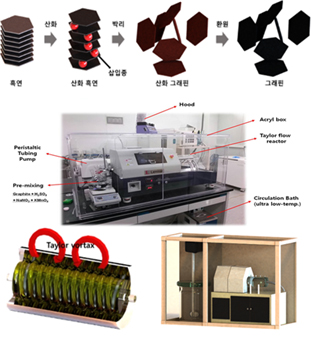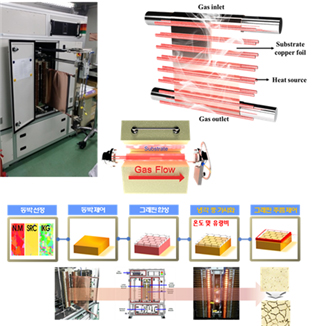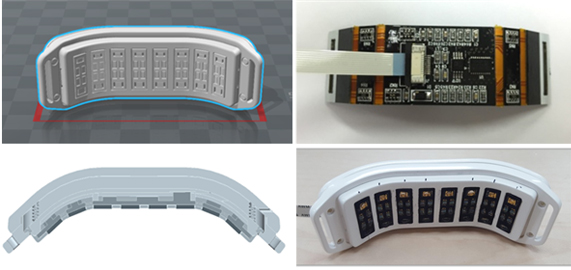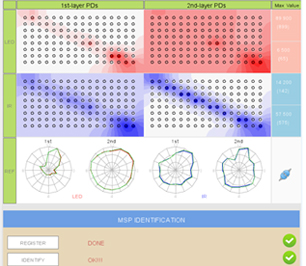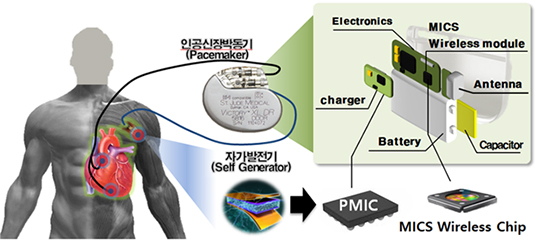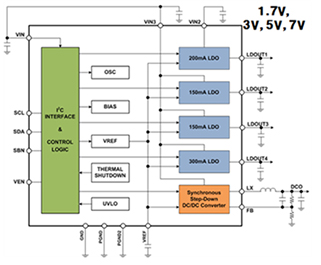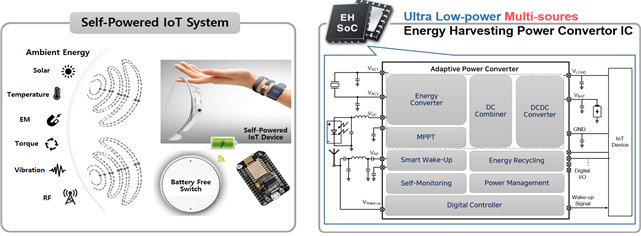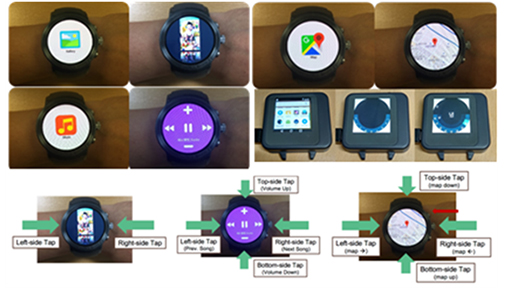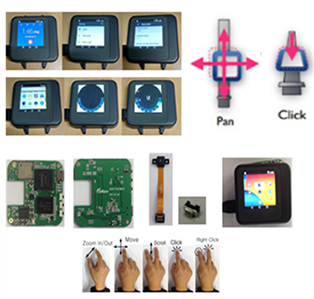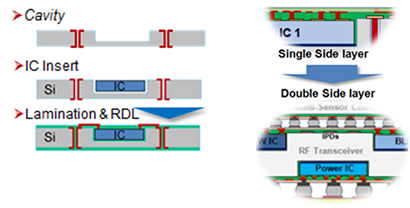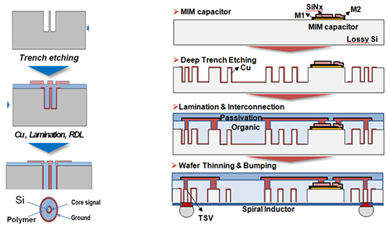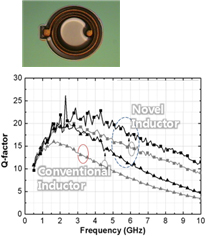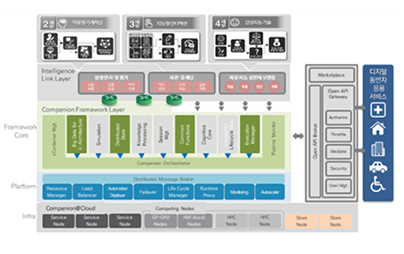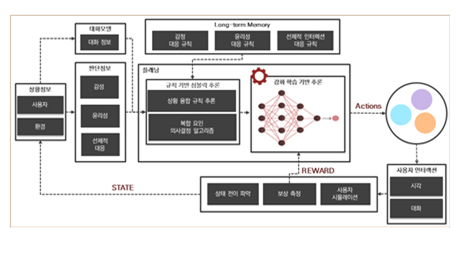Wearable Device
- Concept
-
Economical synthesis of high-quality graphene oxide using recycled waste acid solution with less energy, and rapid synthesis of high-quality wide graphene sheet using rapid thermal chemical vapor deposition (RTCVD)
- Main Features
-
Graphene oxide synthesis
- Oxygen content in graphene oxide < 40%, size > 1μ㎡, thickness < 10nm, production capacity: 2 tons/month
- Recovery rate > 95%, synthesis time < 6 hours, reduced water consumption by 90%, waste acid recovery rate > 85%
- Competing with Angstron Materials’ batch-based graphene oxide manufacturing technology
High-quality, wide graphene production
- An RTCVD-based, fast 30-inch or wider graphene growth technique
- High conductivity (200Ω/sq), high permeability (98%) and uniformity (±5%)
- Expandable up to 400x400㎟
- Applicable to touch panels, sensors, secondary batteries, display electrodes and barriers
- Better in oxidization, diffuse reflection and growth process (coating) than its competitors (AgNW, CNT)
- Applications
-
Touch panelSensorSecondary batteryDisplay
- Concept
-
User authentication and security technology for wearable devices using individual-specific biological data (ECG, optical properties of skin, EEG, etc.)
- Main Features
-
A high-precision wearable authentication device based on ECG and skin patterns
- False rejection rate (FRR) ≤ 2%, false acceptance rate (FAR) ≤ 0.01%
Skin pattern recognition devices and authentication algorithms under development
A platform for auto-control of EEG electrodes and real-time multi-channel EEG signal processing
- Usable with headset-style wearables
- Applications
-
HealthcareWearable deviceSecurityFintech
- Concept
-
Wearable device platform technology for self-charging/power generation and ultra-low power wireless communication of bio-implants
- Main Features
-
Power management integrated circuit (PMIC) technology for bio-implants and communication technology for the medical implant communication service (MICS) under development
- A sub-mW charge/discharge system and high-efficiency charger/generator
- A wireless chipset and ultra-low power wireless transceiver for the MICS band
Competing with energy harvesting-based PMICs including Linear Technology’s LTC3588 and STMicroelectronics’ STV1050
- Applications
-
Wearable deviceMedical useIoT deviceEnvironmental monitoring
- Concept
-
A wireless charging platform which does not require external power by capturing ambient energy to charge devices
- Energy sources: radio frequency (RF), light, piezoelectricity, spin torque, thermoelectric generator (TEG), electromagnetic (EM) radiation, etc.
- Main Features
-
RF-based µW energy capturing technology
Simultaneous multi-device charging (up to 4 devices) and device-to-device power transfer
- Non-directional with resonant inductive coupling and dual-band wireless energy transfer
- Up to 2m magnetic channel communication range, 1.14m dual-mode charging distance, and independent impedance matching
- Wireless charging technologies for different applications (e.g. µW charging power for tags, W for sensors, and 1KW for mobile use)
Technologies for resonant-type chip commercialization (A4WP standard, 82% reception efficiency), fast charging (WPC standard, 2A) and powerless sensor tag commercialization
- Applications
-
Wearable deviceEnergy harvestingIoT
- Concept
-
New interactive UI using multiple touch/touchless methods to overcome the limitations of touchscreen-based UI/UX of smartwatches, smart bands, and other wearables
- Main Features
-
Machine learning-based gesture recognition
Multisensory integration and interaction
User experience evaluation
Touch/touchless UI
- Applications
-
Wearable device
- Concept
-
A high-density wafer-level three-dimensional integrated circuit (3D IC) packaging technique that uses silicon interposers (SI) and through-silicon via (TSV) technology to stack multiple heterogeneous semiconductor components
- Main Features
-
Short interconnection and highly-integrated IC-embedded silicon interposer technology
Coaxial TSV and integration of high-Q passive elements using embedded IC and redistribution layer (RDL) on both sides of a silicon interposer
A hybrid MMIC at millimeter-wave frequencies using a silicon interposer
Cost reduction and CTE mismatching issues solved using organic substrate-based TSV technology
- Applications
-
Wearable deviceMilitary radar
- Concept
-
Artificial intelligence that uses machine learning to process sounds, images, texts, and other inputs; understand intentions, contexts, and emotions; and personalize them and interact autonomously
- Main Features
-
An integrated framework for the operation of heterogeneous algorithms in a single system
- A container design that is easy to build, register, and deploy
- Plug-and-play interface for a container, and component messaging
Artificial intelligence technology
- Preplanning: communication management model using rule-based reinforcement learning
- Autonomous visual intelligence: single-inference multi-label image classification
Integration of AI algorithms created in heterogeneous environments, symbolic and machine learning-based inference, and adaptive label creation using preplanning and autonomous visual intelligence
- Applications
-
Wearable deviceAutonomous drivingIntelligent robot
Copyright(C) 2016 KOREA ELECTRONICS TECHNOLOGY INSTITUTE., All Rights Reserved.


